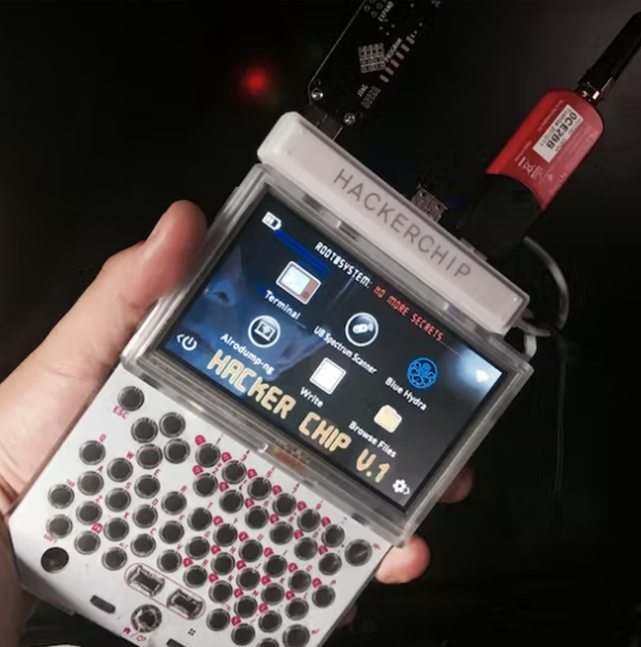HACKCHIP
However, it was running full-fledged Linux, so El Kentaro knew he could easily change it to his liking. After setting up the system to his liking, he first installed Aircrack-ng to sniff wireless networks and basic cracking to get the good stuff. He already has an Ubertooth One on hand (though they cost almost twice as much as the Pocket CHIP itself), so he adds a Bluetooth dongle and BlueHydra for attacking Bluetooth devices.
Next comes some Linux customization and physical modifications. He turned off the boot screen to add a bit of flavor and changed it to easily launch installed hacking software. The PocketCHIP comes with only one USB port, so adding a USB hub is an obvious next step. To keep his fingers from getting too fat, he drilled a hole in the case to fit a standard stylus.
More software was added later, including: Mosh (mobile-friendly SSH client), Hastebin for logging data, and Horst (WiFi scanner and analyzer). He also wrote a script to quickly scan the area to get a sense of the network around him. This setting allows him to check the network around him without looking too obvious in a crowded area.
With the advent of Bluetooth and WiFi, El Kentaro needed a way to use RFID. Luckily, he has a forgotten Proxmark3 buried in his desk. Proxmark3 is another expensive tool, but it gives you everything you need to use RFID. It can scan, hack, and copy RFID cards and tags, and simulate the card and reader (or sniff the communication between the two).
At this point, the Hack Chip starts to resemble something out of Frankenstein's lab. So El Kentaro set out to clean up the equipment and make it less obvious. With all these devices bundled together, it needs some streamlining. Added wireless charging (getting to the charging port is starting to get difficult). And, just for giggles, El Kentaro pulled out an endoscope and made it work well with the Hack Chip.
Now, Hack Chip has just about every hacking gadget and widget you can strap onto your device. But El Kentaro isn't quite done yet, and is making a companion for Hack Chip. Dude is a raspberry PI zero drop box that can be left behind to monitor networks that have been hacked with chips. It will continue to record the data and send it to the Hack Chip, where it will be retrieved.
关于HACKCHIP
El Kentaro wanted a feature-rich hacking station, but wanted to keep it light, portable and unobtrusive. When he came across Next Thing Co. PocketCHIP, a pocket computer for MODs, he knew he had found the perfect platform for the project. PocketCHIP is easy to crack by design, but its real purpose is to be a portable retro gaming system (if marketing materials are any indication).
However, it was running full-fledged Linux, so El Kentaro knew he could easily change it to his liking. After setting up the system to his liking, he first installed Aircrack-ng to sniff wireless networks and basic cracking to get the good stuff. He already has an Ubertooth One on hand (though they cost almost twice as much as the Pocket CHIP itself), so he adds a Bluetooth dongle and BlueHydra for attacking Bluetooth devices.

Next comes some Linux customization and physical modifications. He turned off the boot screen to add a bit of flavor and changed it to easily launch installed hacking software. The PocketCHIP comes with only one USB port, so adding a USB hub is an obvious next step. To keep his fingers from getting too fat, he drilled a hole in the case to fit a standard stylus.
More software was added later, including: Mosh (mobile-friendly SSH client), Hastebin for logging data, and Horst (WiFi scanner and analyzer). He also wrote a script to quickly scan the area to get a sense of the network around him. This setting allows him to check the network around him without looking too obvious in a crowded area.
With the advent of Bluetooth and WiFi, El Kentaro needed a way to use RFID. Luckily, he has a forgotten Proxmark3 buried in his desk. Proxmark3 is another expensive tool, but it gives you everything you need to use RFID. It can scan, hack, and copy RFID cards and tags, and simulate the card and reader (or sniff the communication between the two).

At this point, the Hack Chip starts to resemble something out of Frankenstein's lab. So El Kentaro set out to clean up the equipment and make it less obvious. With all these devices bundled together, it needs some streamlining. Added wireless charging (getting to the charging port is starting to get difficult). And, just for giggles, El Kentaro pulled out an endoscope and made it work well with the Hack Chip.
Now, Hack Chip has just about every hacking gadget and widget you can strap onto your device. But El Kentaro isn't quite done yet, and is making a companion for Hack Chip. Dude is a raspberry PI zero drop box that can be left behind to monitor networks that have been hacked with chips. It will continue to record the data and send it to the Hack Chip, where it will be retrieved.
发货选项
发货选项和价格可能会根据你订单的总价值有所不同。你最终的运费将在结帐时确定。
-
8.00 USD - Rate (Expected the arrival of the goods)
发货尺寸
-
大小0公分 × 0公分 × 0公分
-
重量0.5公斤
